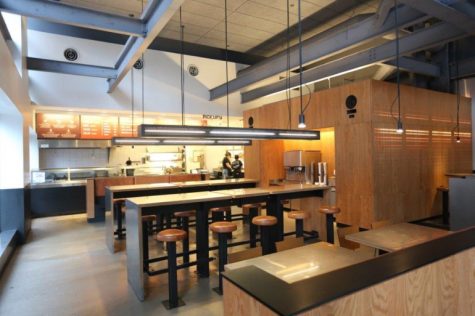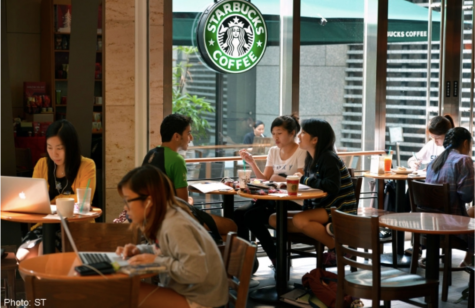The Chipotle-Starbucks Pipeline
Fast food and fast casual restaurants are generally found together within one area, such as outdoor malls and plazas. Restaurants “team up” to help advance each other’s business. These areas will include a variety of popular fast food restaurants to prove to the customers that they have the freedom to pick where they want to eat, making the customers more likely to eat at at least one restaurant as opposed to none at all. As big chain restaurants differ in specialization of food, the restaurant placements will be strategic. For example, the Closter Plaza has a Chipotle and Starbucks right next to each other. When I ate a full lunch at Chipotle with my friends, we had the strange desire to migrate over to Starbucks for a sweet drink. Because the restaurant was so accessible, we ended up eating at both locations rather than one or none. Psychological reasoning indicates the contrast of Chipotle’s meat and rice full meals fit exceptionally well with Starbucks’ sugary desserts and refreshments.
Chipotle’s Urgency

The cool AC blasts in your face as you walk through the doors of Chipotle. You notice the furniture has a sharp, rustic feel. The color scheme is in browns and grays, as well as silvery metals, which Chipotle uses as their tabletops. You go to the back of the store to join the assembly line of creating your bowl. As you shuffle to the side to tell the worker your bowl order, you feel like you’re just a part of a large conveyor belt machine. You pay, go to sit down, and rest your elbows on the cold, rectangular metal table. The bar stools don’t have backs to them, so you physically can’t sit back and relax. The architecture creates a mood where the customers feel like they must eat their food then immediately leave. The restaurant lacks an inviting atmosphere. All they provide is a full-calorie lunch or dinner to eat when you are on an empty stomach. Great for a quick visit, as the restaurant is mostly known for their portable bowls and burritos. After quickly having a savory meal in a cold restaurant, it is only natural for you to want to leave fora change in scenery, as well as an extra tasty dessert.
Starbucks’ Sweet Lounge

You decide to leave Chipotle, satisfied with your meal, but feel like something is missing. Before walking into the Chipotle, you saw a Starbucks right next door. You spontaneously decide to move into the Starbucks, because you might as well have a sugary drink or two while you’re already there. As soon as you walk in, you are hit with the rich aroma of black coffee and your mouth starts to water. You feel your eyes relax from the soft lighting and hear the quiet chatter of people conversing. You decide to order a Pumpkin Spice Latte and you go to sit on a couch while you wait for your order to be made. Some students click away at their laptops and you notice their devices are all plugged into outlets that are nearby. The outlets in the wall encourage the students to stay to study for hours. Starbucks gives an entrancing atmosphere because they want their customers to relax, stay for a while, and get up several times to buy more things to eat.

The two restaurants, when placed side by side, create a very distinct relationship with each other. Combined, the atmosphere and food of Chipotle and Starbucks, will make people want to have their full meal at Chipotle and then get up for a change of scenery and finish off with a sweet drink or pastry for dessert. People wanting something sugary after eating meat is a brilliant marketing strategy. Making the desserts so accessible, as close as next door, will undoubtedly raise success for the restaurants. Stores will read into the needs of people to know what kind of psychological tactics will bring more customers to their businesses.
So, what does this say about the values of us as a society? The fact that these two very different restaurants are placed together suggests that we value dynamic experiences and variety. We can’t help but love customization, craft, quality, and the ability to make a choice. We want to move from one place to another in a natural chain of events, as if we were born into this world just to walk into that Starbucks next door. Instead of the actual food, the transition of traveling between the two stores is what we live for. Making the decision of going into the Starbucks may make us feel like we’re being productive and running errands, when nothing was really accomplished in the grand scheme of things. We must understand that American food industries have created a powerful and effective system of store placement to play into the hearts and minds of us as customers.
Your donation will support the student journalists of Cresskill High School. Your contribution will allow us to purchase equipment and cover our annual website hosting costs.









